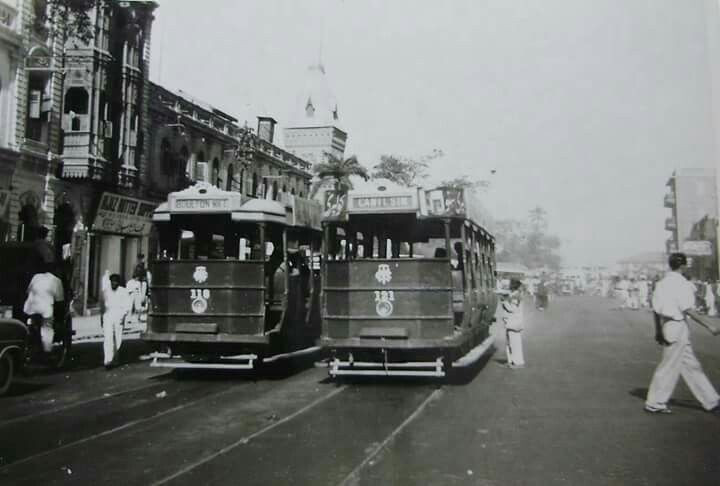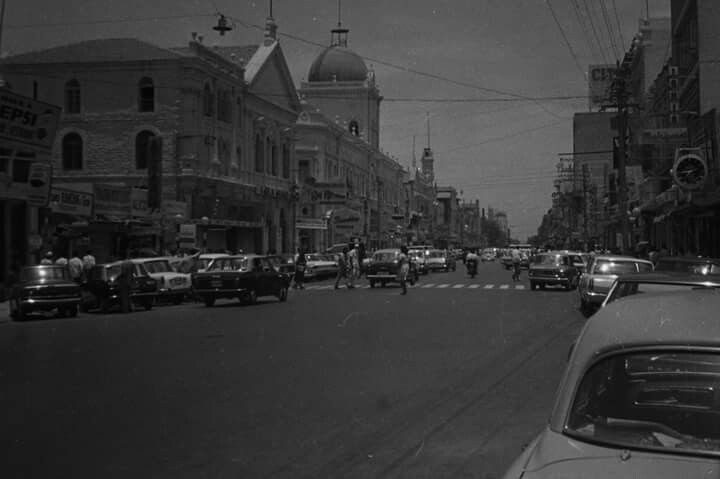There is a ‘saddar’ or a city centre in any old city, including the ancient ones in Cairo, Istanbul and Damascus, but the Saddar of Karachi is different or at least it was until a few decades ago. Call it bias, prejudice or a partisan thought, but for me it shall remain so, for it is associated with memories of my childhood and teenage years.
The word saddar, derived from Arabic, loosely means the chest, centre or downtown, and in today’s parlance, it is meant to indicate the central or main bazaar. In British India, alongside the garrison, bazaars were set up and referred to as ‘Saddar’. In 1839, the British created Saddar in Karachi, and since then, it has remained a central business district with beautiful colonial architecture as a remnant of the British occupation. The landmarks the British built here include the Empress Market, St. Patrick’s School, St. Joseph’s School and St. Patrick’s Cathedral. Saddar even had a dress code imposed on it, similar to the French, Belgian and British Concessions in Shanghai, where various schemes of diabolical nature such as dress and language protocols etc. denied locals the right of entry.
I did not live in Saddar, but daily spent hours walking alongside my father, who on a school holiday would take me to his office and meetings. Saddar is not limited to what I write here, because a complete overview would require a thick supplement. Let me take you to visit Saddar of the late sixties and seventies, as an amendment to the song ‘Last time I saw Paris’ to ‘Last time I saw Saddar’ reveals my sentiments to you.
Zooming down from the Quaid’s Mazaar towards the port on Bunder Road, now known as M.A. Jinnah road, used to be tidy and clean, because then it was customary to have the roads washed every single day as there was no tanker mafia to contend with, and there was abundant and free water supply. Between cars and the tram, a camel cart or two would lazily shuffle towards the port. It was great fun to see life-sized posters draped over Nishat and Naz cinema-house facades where the images of actors were a far cry from what they actually looked like ― Shamim Ara looked like Pinocchio and the elegant Zeba was reduced to a vampire! Wonder where those Picassos and Michael Angelos who painted these posters are now.
The streets in the Saddar that I mostly frequented were Victoria Road, now Abdullah Haroon Road, and Elphinstone Street which is now called Zaibunnisa Street and was considered the Picadilly Circus of Karachi. Mountstuart Elphinstone was the first British ambassador to Kabul and later became the Governor of Bombay Presidency, which Karachi was a part of. Victoria Road was named after the queen. Renaming of streets cannot undo history. If we want to honour someone, let’s build new roads to name after them, and not steal history. By renaming the cities in Hindustan, Modi is trying to dislodge, and certainly with failure, the 1000 year of glorious Muslim rule in the subcontinent.

From Bunder Road, a left turn into Victoria Road brought us to the Zelin’s Corner, famous for its cafe offering the finest coffee and tea. From its establishment in 1930, then styled as India coffee house, it later became known as Eastern Coffee House and since the mid-fifties it was popularly known as Zelin’s Corner. Further up the road was Cafe Shezan known for its confectionery and delicacies. Across Shezan, was the Pioneer restaurant, famous for its khichrra. Alongside, the BVS Parsi School with its immense contribution to education still stands impressive and dignified. In those days, the traffic was so organised and the population of Karachi so in control that school timings did not create a major traffic ruckus. There was no electronic or mobile phone market, hence half the road wasn’t occupied by nests of motorbikes.
Further up at the traffic light junction, on the right was St. George’s Café, one of my favourite restaurants. It was known as a happening place where the intelligentsia met to relish the tastiest patties with the cafe’s signature green chutney.
Regal Chowk, crowded with people, buyers and sellers of a variety of stuff from Taiwanese toys to toothpowder, has never ever had a dull moment. On Sundays when the shops would be shut, the footpaths would turn into bookshops of old books and magazines. Bargain hunters like me would get many books of choice for dirt-cheap prices. Today, either the book market has vanished or moved into some obscure by-lane as people have lost interest in books and reading.
A few paces away was the Parisian Bakery where the cream rolls were to die for. On Victoria Road, past the Paradise cinema was the Jabees Hotel, a swank haunt for celebrities and film stars. Its United Restaurant was famous for its fried fish and cutlets, while diagonally across was the Hong Kong Restaurant offering Chinese cuisine, both the bland Cantonese dishes and the sizzling Sichuan ones. Other Chinese restaurants in the area included the ABC Restaurant, the South China, and the Four Seasons at the Metropole Hotel, which were frequented by Karachiites who had fallen already fallen madly and deeply in love with Chinese food.
A block away was the Cooperative Market frequented mostly by tourists looking for souvenirs. Bang opposite was the imposing Saddar Post Office, with professional letter-writers available outside to the migrant labour in Karachi who sent money orders accompanied by letters that they would dictate to them. The letter-writers would also read their incoming mail to them, a glint in their eyes at any special endearments and sweet nothing for the beloved recipient. For cheap thrills, passersby would also stop for a few minutes to listen to these torrid letters.
The newly-built, multi-storeyed Mehboob Baksh market was the Dolmen Mall of yesteryear. It was first of its kind in Pakistan with a parking lot and shops on a few floors, while the upper storeys housed offices. Now, the filth around here is reflective of the decline in our social standards.
At one end of Victoria Road was the Rex cinema that mostly showed Hollywood films, and hence was a favourite with the elite of the city. Outside the cinema was the Fountain Chowk, with a musical fountain, which is now associated with the Karachi Press Club, located nearby. A left turn from the Rex cinema would take you to Topsy where you could get delicious square-shaped ice cream and falooda along with other drinks. People would compare it to the falooda from Alpha Restaurant on Inverarity Road, which also had a bookshop where we would go on a shopping spree that would be rounded off with a falooda treat from either of the above mentioned places.

Not far was our Piccadilly, the Elphinstone Street. It was showcased to foreign dignitaries visiting Pakistan. One such vivid memory relates to President Lyndon B. Johnson’s (hope I am not confusing with Jacqueline Kennedy) visit to Karachi. In an open motorcade, he stood beside the imposing personality of President Ayub Khan. As school children we had lined up to wave at the highly-esteemed visitors. Life was peaceful with no fears of terrorist attacks. Everything around was organised and disciplined. Jaywalkers, crossing streets at points other than zebra crossings were challenged with monetary fines. By night, while Victoria Road with its numerous neon signs looked like Queens Street in Hong Kong, the Elphinstone Street was actually closer in resemblance to Regent Street in London. The Rio cinema nearby showcased both English and Urdu films. If Rex was elitist, Rio was the more awami cinema. The Harrod’s of Karachi was Sanaullah, where everything was expensive, so only the rich and famous would shop there and preserve the shopping bags to show them off later. A few blocks away was the Al-Farooq Restaurant that offered the juiciest chicken tikkas.
At the far end of Saddar was the St. Patrick’s Cathedral and the Christian missionary schools and colleges, where the Catholic Goan community lived in the surrounding apartment blocks. Nearby, the United Bakery still caters Christmas cakes, Easter buns, eclairs, cream puffs and chicken patties to the Goan community and everyone else who loves baked goods and confectionary. After India seized Goa and Pondicherry from the Portuguese, many Goans came and settled in Karachi. The contributions of this community to the field of education is paralleled only by the Parsi community. We neither acknowledge nor pay tribute to these communities for giving our country literates, and a disciplined work force generation after generations.
Ensconced between the Cathedral and Elphinstone is the 100 year old Bohri Bazar, a mish-mash of shops that sell everything under the sun. Its narrow lanes hid the Capital cinema, where Secret Agent FX 18 (1968) was the first film that I watched with my eldest brother. Facing the theatre was the famous fruit chatwallah (vendor) whose spicy fruit chaat with chickpeas was very popular.
Moving on to the more hip side of Saddar, where one could not miss the infamously famous Excelsior Hotel, where displayed outside the modern building were life-sized posters of glamourous and titillating Lebanese, Egyptian and Turkish troupe dancers. Out of bounds for the young ofcourse, tourist and non-tourists would enjoy floor-shows and cabaret performances at its nightclub ‘The Penthouse.’ Nobody was offended, no one ever tore down the posters or spray-painted clothes on the women in these posters. We were a tolerant society. Each to his thought and space, with the responsibility to ensure that none of these activities would undermine the social fabric, which was then far stronger, than now.
Close to Empress Market was a liquor shop which barely had any customers inside the shop. Possibly because there was religious prohibition, and not administrative, therefore the urge to partake may have been low, unlike today. Nearby Empress Market was the famous Peshawari ice cream joint, the taste was addictive and still is.
Several Iranian cafes such as Cafe Gulzar, Cafe Jahangir, and Cafe Darakhshan with typically designed interiors littered Saddar. Marble-slab table tops, no napkins, one sugar pot serving at least three tables, waiters who seemed trained to bang glasses on the table, and chairs designed to be uncomfortable so you wouldn’t want to linger with a cup of tea, the quality of which was unquestionably excellent.
Couples walked holding hands on the streets, tourists walked around the streets, bazaars and the beaches, and girls and women wore fashionable clothes on the streets, no body imposed, nobody judged. It was a Karachi that had a distinct style, a modern vibe, and lots of hope. Sadly, Karachi has been wrecked by the vagaries of time, which is ruthless in its fury. Earlier the infirmities were adequately covered by passion of affection. But no more.
Poverty in all its formats and manifestations destroys all virtues. A populous city is invariably ill-governed, even Aristotle believed that few good men do not necessarily make good citizens. The dust of decades of neglect has settled permanently on the facade of Saddar. Muck and money go together, the delineating lines are blurred. Karachi’s ruin is the ruin of the country. A virtuous city it was then, ask any child or a fool, both don’t lie. Administrative intrusion has led the area into an abyss.
But I love thee still Saddar, poetry to the prose of Karachi. If anyone is tired of Saddar’s beauty, that person is certainly tired of life.
Sirajuddin Aziz is a senior banker and freelance writer. All information and facts are the sole responsibility of the writer
